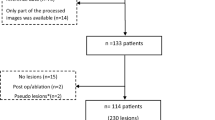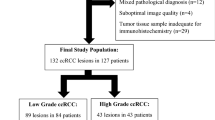Abstract
Objective
To evaluate the performance of a novel, quantitative computer-aided diagnostic (CAD) algorithm on four-phase multidetector computed tomography (MDCT) to detect peak lesion attenuation to enable differentiation of clear cell renal cell carcinoma (ccRCC) from chromophobe RCC (chRCC), papillary RCC (pRCC), oncocytoma, and fat-poor angiomyolipoma (fp-AML).
Materials and methods
We queried our clinical databases to obtain a cohort of histologically proven renal masses with preoperative MDCT with four phases [unenhanced (U), corticomedullary (CM), nephrographic (NP), and excretory (E)]. A whole lesion 3D contour was obtained in all four phases. The CAD algorithm determined a region of interest (ROI) of peak lesion attenuation within the 3D lesion contour. For comparison, a manual ROI was separately placed in the most enhancing portion of the lesion by visual inspection for a reference standard, and in uninvolved renal cortex. Relative lesion attenuation for both CAD and manual methods was obtained by normalizing the CAD peak lesion attenuation ROI (and the reference standard manually placed ROI) to uninvolved renal cortex with the formula [(peak lesion attenuation ROI − cortex ROI)/cortex ROI] × 100%. ROC analysis and area under the curve (AUC) were used to assess diagnostic performance. Bland–Altman analysis was used to compare peak ROI between CAD and manual method.
Results
The study cohort comprised 200 patients with 200 unique renal masses: 106 (53%) ccRCC, 32 (16%) oncocytomas, 18 (9%) chRCCs, 34 (17%) pRCCs, and 10 (5%) fp-AMLs. In the CM phase, CAD-derived ROI enabled characterization of ccRCC from chRCC, pRCC, oncocytoma, and fp-AML with AUCs of 0.850 (95% CI 0.732–0.968), 0.959 (95% CI 0.930–0.989), 0.792 (95% CI 0.716–0.869), and 0.825 (95% CI 0.703–0.948), respectively. On Bland–Altman analysis, there was excellent agreement of CAD and manual methods with mean differences between 14 and 26 HU in each phase.
Conclusion
A novel, quantitative CAD algorithm enabled robust peak HU lesion detection and discrimination of ccRCC from other renal lesions with similar performance compared to the manual method.




Similar content being viewed by others
References
Tsili AC, Argyropoulou MI (2015) Advances of multidetector computed tomography in the characterization and staging of renal cell carcinoma. World J Radiol 7(6):110–127.
American Cancer Society (2016) Cancer Facts & Figures 2016, American Cancer Society, Atlanta.
Frank I, Blute ML, Cheville JC, Lohse CM, Weaver AL, Zincke H (2003) Solid renal tumors: an analysis of pathological features related to tumor size. J Urol 170(6 Pt 1):2217–2220.
Silverman SG, Israel GM, Herts BR, Richie JP (2008) Management of the incidental renal mass. Radiology 249:16–31.
Kutikov A, Fossett LK, Ramchandani P, et al. (2006) Incidence of benign pathologic findings at partial nephrectomy for solitary renal mass presumed to be renal cell carcinoma on preoperative imaging. Urology 68:737–740.
Jinzaki M, Silverman SG, Akita H, Nagashima Y, Mikami S, Oya M (2014) Renal angiomyolipoma: a radiological classification and update on recent developments in diagnosis and management. Abdom Imaging 39(3):558–604.
Gill IS, Aron M, Gervais DA, et al. (2010) Small renal mass. N Engl J Med 362:624–634.
Low G, Huang G, Fu W, Moloo Z, Girgis S (2016) Review of renal cell carcinoma and its common subtypes in radiology. World J Radiol 8(5):484–500.
Cheville JC, Lohse CM, Zincke H, Weaver AL, Blute ML (2003) Comparisons of outcome and prognostic features among histologic subtypes of renal cell carcinoma. Am J Surg Pathol 27:612–624.
Leone AR, Diorio GJ, Spiess PE, Gilbert SM (2016) Contemporary issues surrounding small renal masses: evaluation, diagnostic biopsy, nephron sparing, and novel treatment modalities. Oncology 30(6):507–514.
Patel H, Iyoha E, Pierorazio P, et al. (2016) A systematic review of research gaps in the evaluation and management of localized renal masses. Urology. doi:10.1016/j.urology.2016.08.013.
Richard PO, Jewett MA, Tanguay S, et al. (2016) Safety, reliability and accuracy of small renal tumor biopsies: results of a multi-institution registry. BJU. doi:10.1111/bju.13630.
Gould MK (2014) Clinical practice: lung-cancer screening with low-dose computed tomography. N Engl J Med 37(19):1813–1820.
Bota S, Piscaglia F, Marinelli S, Pecorelli A, Terzi E, Bolondi L (2012) Comparison of international guidelines for noninvasive diagnosis of hepatocellular carcinoma. Liver Cancer 1(3–4):190–200.
Runge VM (2013) Current technological advances in magnetic resonance with critical impact for clinical diagnosis and therapy. Invest Radiol 48(12):869–877.
Veeratterapillay R, Ijabla R, Conaway D, Haslam P, Soomro N, Heer R (2015) Contrast-enhanced CT in 100 clear cell renal cell cancers—an analysis of attenuation, tumour size, and survival. Clin Radiol 70(12):1357–1361.
Zokalj I, Marotti M, Koaric B (2014) Pretreatment differentiation of renal cell carcinoma subtypes by CT: the influence of different tumor attenuation measurement approaches. Int Urol Nephrol 46:1089–1100.
Young JR, Margolis D, Sauk S, Pantuck AJ, Sayre J, Raman SS (2013) Clear cell renal cell carcinoma: discrimination from other renal cell carcinoma subtypes and oncocytoma at multiphasic multidetector CT. Radiology 267(2):444–453.
Lee-Felker S, Felker E, Tan N, et al. (2014) Qualitative and quantitative MDCT features for differentiating clear cell renal cell carcinoma from other solid renal cortical masses. AJR Am J Roentgenol 203(5):W516–W524.
Zhang J, Lefkowitz RA, Ishill NM, et al. (2007) Solid renal cortical tumors: differentiation with CT. Radiology 244(2):494–504.
Ruppert-Kohlmayr AJ, Uggowitzer M, Meissnitzer T, Ruppert G (2004) Differentiation of renal clear cell carcinoma and renal papillary carcinoma using quantitative CT attenuation parameters. AJR Am J Roentgenol 183(5):1387–1391.
Pierorazio PM, Hyams ES, Tsai S, et al. (2013) Multiphasic attenuation patterns of small renal masses (≤4 cm) on preoperative computed tomography: utility for distinguishing subtypes of renal cell carcinoma, angiomyolipoma, and oncocytoma. Urology 81(6):1265–1271.
Ishigami K, Pakalniskis M, Leite L, et al. (2015) Characterization of renal cell carcinoma, oncocytoma, and lipid-poor angiomyolipoma by unenhanced, nephrographic, and delayed phase contrast-enhanced computed tomography. Clin Imaging 39:76–84.
Kim JK, Park SY, Shon JE, Cho KS (2004) Angiomyolipoma with minimal fat: differentiation from renal cell carcinoma at biphasic helical CT. Radiology 230:677–684.
Bird V, Kanagarajah P, Morillo G, et al. (2011) Differentiation of oncocytoma and renal cell carcinoma in small renal masses (<4 cm): the role of 4-phase computerized tomography. World J Urol 29:787–792.
Bata P, Gyebnar J, Tarnoki D, et al. (2013) Clear cell renal cell carcinoma and papillary renal cell carcinoma: differentiation of distinct histological types with multiphase CT. Diagn Interv Radiol 19:387–392.
Gakis G, Kramer U, Schilling D, Kruck S, Stenzl A, Schlemmer H (2011) Small renal oncocytomas: differentiation with multiphase. CT Eur J Radiol 80:274–278.
Choi S, Jeon S, Chang S (2012) Characterization of small renal masses less than 4 cm with quadriphasic multidetector helical computed tomography: differentiation of benign and malignant lesions. Korean J Urol 53(3):159–164.
Mashni JW, Assel M, Maschino A, et al. (2015) New chronic kidney disease and overall survival after nephrectomy for small renal cortical tumors. Urology 86(6):1137–1143.
Zini L, Perrotte P, Capitanio U, et al. (2009) Radical vs partial nephrectomy: effect on overall and noncancer mortality. Cancer 115:1465–1471.
Samplaski MK, Zhou M, Lane BR, et al. (2011) Renal mass sampling: an enlightened perspective. Int J Urol 18:5–19.
Leveridge M, Finelli A, Kachura J, et al. (2011) Outcomes of small renal mass needle core biopsy, nondiagnostic percutaneous biopsy, and the role of repeat biopsy. Eur Urol 60:578–584.
Maturen KE, Nghiem HV, Caoili EM, et al. (2007) Renal mass core biopsy: accuracy and impact on clinical management. Am J Roentgenol 188:563–570.
Veltri A, Garetto I, Tosetti I, et al. (2011) Diagnostic accuracy and clinical impact of imaging-guided needle biopsy of renal masses. Retrospective analysis on 150 cases. Eur Radiol 21(2):393–401.
Neuzillet Y, Lechevallier E, Andre M, et al. (2004) Accuracy and clinical role of fine needle percutaneous biopsy with computerized tomography guidance of small renal masses. J Urol 171:1802–1805.
Wood BJ, Khan MA, McGovern F, et al. (1999) Imaging guided biopsy of renal masses: Indications, accuracy and impact on clinical management. J Urol 161:1470–1474.
Ambani S, Morgan T, Montgomery J, et al. (2016) Predictors of delayed intervention for patients on active surveillance for small renal masses: does renal mass biopsy influence our decision? Urology. doi:10.1016/j.urology.2016.08.013.
Rosenkrantz A, Matza B, Portnoy E, et al. (2014) Impact of size of region-of-interest on differentiation of renal cell carcinoma and renal cysts on multi-phase CT: preliminary findings. Eur J Radiol 83:239–244.
Van Ginneken B, Schaefer-Prokop CM, Prokop M (2011) Computer-aided diagnosis: how to move from the laboratory to the clinic. Radiology 261:719–732.
Summers RM (2016) Progress in fully automated abdominal CT interpretation AJR 207:67–79.
Linguraru MG, Wang S, Shah F, et al. (2009) Computer-aided renal cancer quantification and classification from contrast-enhanced CT via histograms of curvature-related features. Conference Proceedings of IEEE Engineering in Medicine and Biology Society, pp 6679–6682.
Linguraru MG, Gautam R, Peterson J, et al. (2009) Renal tumor quantification and classification in triple-phase contrast-enhanced abdominal CT. Proceedings of the IEEE International Symposium on Biomedical Imaging, pp 1310–1313.
Linguraru MG, Wang S, Shah F, et al. (2011) Automated noninvasive classification of renal cancer on multiphase CT. Med Phys 38(10):5738–5746.
Kim DY, Park JW (2004) Computer-aided detection of kidney tumor on abdominal computer tomography scans. Acta Radiol 45(7):791–795.
Liu J, Wang S, Linguraru MG, Yao J, Summers RM (2015) Computer-aided detection of exophytic renal lesions on non-contrast CT images. Med Image Anal 19(1):15–29.
Lee Y, Kim JK, Shim W, et al. (2015) Does computer-aided diagnosis permit differentiation of angiomyolipoma without visible fat from renal cell carcinoma on MDCT? AJR 205:W305–W312.
Pano B, Macias N, Salvador R, et al. (2016) Usefulness of MDCT to differentiate between renal cell carcinoma and oncocytoma: development of a predictive model. AJR 206(4):764–774.
Divgi C, Uzzo R, Gatsonis C, et al. (2012) Positron emission tomography/computed tomography identification of clear cell renal cell carcinoma: results from the REDECT trial. J Clin Oncol 31(2):187–194.
Gorin M, Rowe S, Baras A, et al. (2016) Prospective evaluation of 99mTc-sestamibi SPECT/CT for the diagnosis of renal oncocytomas and hybrid oncocytic/chromophobe tumors. Eur Urol 69(3):413–416.
Rowe SP, Gorin MA, Gordetsky J, et al. (2015) Initial experience using 99mTc-MIBI SPECT/CT for the differentiation of oncocytoma from renal cell carcinoma. Clin Nucl Med 40(4):309–313.
Raman SP, Chen Y, Schroeder JL, Huang P, Fishman EK (2014) CT texture analysis of renal masses: pilot study using random forest classification for prediction of pathology. Acad Radiol 21(12):1587–1596.
Author information
Authors and Affiliations
Corresponding author
Ethics declarations
Funding
No funding was received for this study.
Conflicts of interest
All authors have no conflicts of interest.
Ethical approval
All procedures performed in studies involving human participants were in accordance with the ethical standards of the institutional and/or national research committee and with the 1964 Helsinki Declaration and its later amendments or comparable ethical standards. For this type of study formal consent is not required.
Informed consent
Institutional review board (IRB) approval for a waiver of informed consent was received for this retrospective study.
Rights and permissions
About this article
Cite this article
Coy, H., Young, J.R., Douek, M.L. et al. Quantitative computer-aided diagnostic algorithm for automated detection of peak lesion attenuation in differentiating clear cell from papillary and chromophobe renal cell carcinoma, oncocytoma, and fat-poor angiomyolipoma on multiphasic multidetector computed tomography. Abdom Radiol 42, 1919–1928 (2017). https://doi.org/10.1007/s00261-017-1095-6
Published:
Issue Date:
DOI: https://doi.org/10.1007/s00261-017-1095-6




